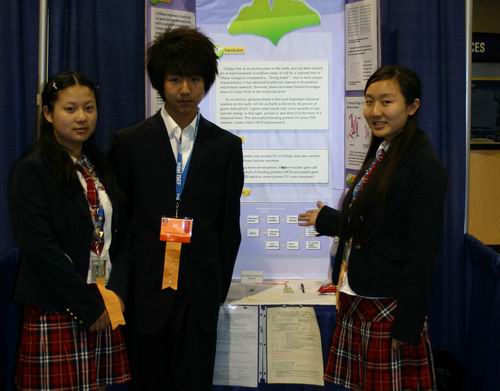өЪ58ҢГIntel ISEFЦРҮш…ўЩҗн—ДҝЈәгyРУD1ө°°Ч»щТтҝЛВЎЕcУЧГзИ~Ж¬°l(fЁЎ)Уэ•rұнЯ_(dЁў)өДСРҫҝ
іЙ¶јКРөЪЖЯЦРҢW(xuЁҰ) ёЯ¶ю ¶Е¬| ЦЬкҗіҝ ҸҲөд
гyРУЈЁGinkgo bioloba L.Ј©КЗ¬F(xiЁӨn)ҙж·NЧУЦІОпЦРЧо№ЕАПөДКАҪзЦшГы»о»ҜКҜЦ®Т»Ј¬КЗЦРҮшЛщМШУРөДөЪЛДјo(jЁ¬)ұщҙЁжЭЯzЦІОп����ЎЈһйБЛБЛҪвгyРУУЧГзИ~Ж¬°l(fЁЎ)Уэ•r№вәП»щТтөДұнЯ_(dЁў)�Ј¬ј°ЖдЕcјҡ(xЁ¬)°ыәЛЩ|(zhЁ¬)»ҘЧчәНИ~Ж¬№вәП№ҰДЬҢҚ¬F(xiЁӨn)өДкP(guЁЎn)ПөЈ¬ұҫОДКЧҙОАыУГRT-PCRәН3’RACE·Ҫ·Ё��Ј¬”U(kuЁ°)ФцгyРУD1ө°°Ч»щТтөДҫҺҙa…^(qЁұ)ЈЁТСФЪGenbankөЗк‘Ј©�����ЎЈҢҰРтБРңy¶ЁҪY(jiЁҰ)№ыЯM(jЁ¬n)РРЙъОпРЕПўҢW(xuЁҰ)·ЦОцәНЯM(jЁ¬n)»Ҝ·ЦОц���Ј»АыУГ·ЦЧУлsҪ»әНГвТЯУЎЫE·Ҫ·Ё���Ј¬ҢҰгyРУУЧГзИ~Ж¬°l(fЁЎ)УэЦРЦШТӘ№вәП»щТт»щТтpsbAәНcabұнЯ_(dЁў)өДmRNAәНө°°ЧЩ|(zhЁ¬)Л®ЖҪЯM(jЁ¬n)РРБЛ¶ЁБҝөД·ЦОцЎЈіхІҪМҪУ‘БЛгyРУУЧГзИ~Ж¬°l(fЁЎ)УэЦР№вәПЧчУГ»щТтұнЯ_(dЁў)�����Ўўјҡ(xЁ¬)°ыәЛЩ|(zhЁ¬)»ҘЧчөДкP(guЁЎn)Пө�����ЎЈФЪгyРУУЧГз°l(fЁЎ)УэіхЖЪЈ¬оҗДТуwДӨМҺУЪЧғ»ҜЦР��Ј¬И~ҫGЛШәПіЙјУҝм�Ј¬ҪM·ЦұИАэёДЧғәНИ~ҫGуwөД°l(fЁЎ)Уэ о‘B(tЁӨi)•юІ»Н¬іМ¶ИөШУ°н‘№вПөҪy(tЁҜng)IIҒҶ»щөДҙъЦxЛ®ЖҪЎЈ

A Study of psbA Gene Cloning and Expression in the Leaves of Ginkgo Seedlings
Plant Sciences
Du Wei, Zhou Chenchen, Zhang Dian 17, No. 7 Middle School of Chengdu City
Ginkgo (Ginkgo biloba L.), one of the oldest living tree species, is the only living member of the gymnosperms division Ginkgophyta. It is considered a “living fossil”, unchanged since the time of dinosaurs, and seen as one of the wonders of the world. Due to such unique characteristics, it has attracted worldwide interest in biomedical and botanic research. However, there have been limited investigations of Ginkgo biloba at the molecular level.
The objective of this project is to understand how the chloroplast-encoded photosynthesis genes are expressed in the leaves of Ginkgo seedlings, and whether the nuclei and chloroplast genetic systems participate in a concerted manner in the early phases of Ginkgo biloba seedling growth. For the first time, we applied RT-PCR and 3’-RACE methods to clone a cDNA fragment of the psbA gene, which encodes the protein D1 of photochemical reaction center, from Ginkgo biloba. Protein sequence showed that the Ginkgo D1 protein is identical to D1 protein found in many other plants. Both Western blot and Northern blot were used to analyze the levels of protein and mRNA of psbA and cab genes. Our project results suggest that the thylakoid membrane goes through constant changes and chlorophyll synthesis speeds up during the early phases of leaf growth. The structural and functional status of chloroplast may influence the expression of photosystem II subunits during ginkgo seedling development.